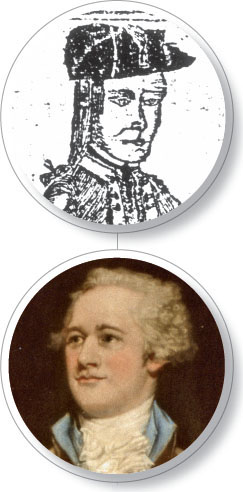Exploring American Histories: Printed Page 193
Exploring American Histories, Value Edition: Printed Page 163
American Histories: Daniel Shays and Alexander Hamilton
AMERICAN HISTORIES

Like many young farmers in Massachusetts, Daniel Shays enlisted in a local militia company in the early 1770s. Born to Irish parents in Hopkinton, Massachusetts, in 1747 and one of six children, Daniel received little formal education. In 1772 he married, had a child, and settled into farming. But in April 1775, he, his father, and his brother grabbed muskets and raced toward Concord to meet the British forces. By June, he was among the patriots defending Breed’s Hill and Bunker Hill.
After distinguished service in the Continental Army, Shays resigned from service in 1780 and purchased a farm in Pelham, Massachusetts. He hoped to return to a normal life, but in the years following the Revolution, the nation entered a period of economic turmoil. Farmers in western Massachusetts, many deeply in debt, were especially hard hit. Debtors, including former soldiers and their families, lost their land, tools, livestock, clothes, and furniture, and many were also imprisoned. Although Shays managed to keep his farm, many of his neighbors faced eviction. Shays was chosen to represent his town at county conventions that petitioned the state government for economic relief. However, the Massachusetts legislature, sitting in Boston, largely ignored their concerns.
Angered by the legislature’s failure to act, armed groups of farmers attacked courthouses throughout western Massachusetts in 1786. Although Shays was reluctant to lead the movement, he soon headed the largest contingent of farmer-soldiers, a band that eventually numbered more than a thousand men. After a series of small skirmishes against local militias, Massachusetts governor James Bowdoin moved to quash the rebellion. In January 1787, Shays and his men headed to the federal arsenal at Springfield, Massachusetts, to seize guns and ammunition. The farmers were routed by state militia and pursued by the governor’s army. Many rebel leaders were captured; others, including Shays, escaped to Vermont and later New York State. Four were convicted and two were hanged before Bowdoin granted amnesty to the rest of the rebels, in hopes of avoiding further conflict.
This uprising, known as Shays’s Rebellion, fueled grave concern on the part of many state and national leaders. They feared that the U.S. government was too weak to put down such insurgencies and advocated amending or replacing the Articles of Confederation to create a new political structure that would strengthen federal power. Among those outraged by the rebels was Alexander Hamilton, a young New York politician with an admirable record of military service. Hamilton was born illegitimate and impoverished in the British West Indies. Orphaned at eleven, he was apprenticed to a firm of merchants, where his gift for commerce and finance quickly became clear. The firm sent him for schooling to the American colonies, where he was drawn into the activities of radical patriots. Hamilton joined the Continental Army in 1776 and gained a reputation as courageous, even reckless, in the pursuit of military glory.
During the war, Hamilton fell in love with Elizabeth Schuyler, who came from a wealthy New York family, and they married in December 1780. After the American victory, Hamilton used military and marital contacts to establish himself as a lawyer and financier in New York City. In 1786 he focused his efforts on improving the state of the nation’s finances. He was elected to the New York State legislature that spring and by fall was serving as a delegate to a convention on interstate commerce held in Annapolis, Maryland. Hamilton was among a small group of delegates who sought to strengthen the central government. They pushed through a resolution calling for a second convention “to render the constitution of the Federal Government adequate to the exigencies of the Union.”
Although the initial response to the call was lukewarm, the eruption of Shays’s Rebellion and the federal government’s financial problems soon convinced many in the congress and the states that change was required. Although Hamilton played only a small role in the 1787 convention in Philadelphia, he worked tirelessly for ratification of the Constitution drafted there. Once the new federal government was established, in the fall of 1789 Hamilton accepted appointment to the job he most deeply desired, secretary of the treasury. •
AS ALEXANDER HAMILTON took charge of the nation’s economic policy, Daniel Shays retreated to a modest living on the frontiers of New York State. Despite the suppression of Shays’s Rebellion, the grievances that fueled the uprising persisted, and other problems confronted the new nation as well. Moreover, Hamilton’s efforts to stabilize and strengthen the national economy, although deemed successful by many political and economic elites, sparked controversy and conflicts in the years ahead. As the American histories of Daniel Shays and Alexander Hamilton demonstrate, Americans may have come together to win the Revolutionary War, but not all Americans shared a common vision of the independent nation that military victory made possible.